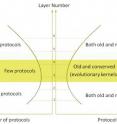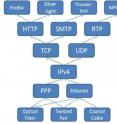(click to enlarge)

(Credit: Constantine Dovrolis)
In the natural world, species that share the same ecosystem often compete for resources, resulting in the extinction of weaker competitors. A new computer model that describes the evolution of the Internet's architecture suggests something similar has happened among the layers of protocols that have survived -- and become extinct -- on the worldwide network.
Understanding this evolutionary process may help computer scientists as they develop protocols to help the Internet accommodate new uses and protect it from a wide range of threats. But the model suggests that unless the new Internet avoids such competition, it will evolve an hourglass shape much like today's Internet.

No comments:
Post a Comment